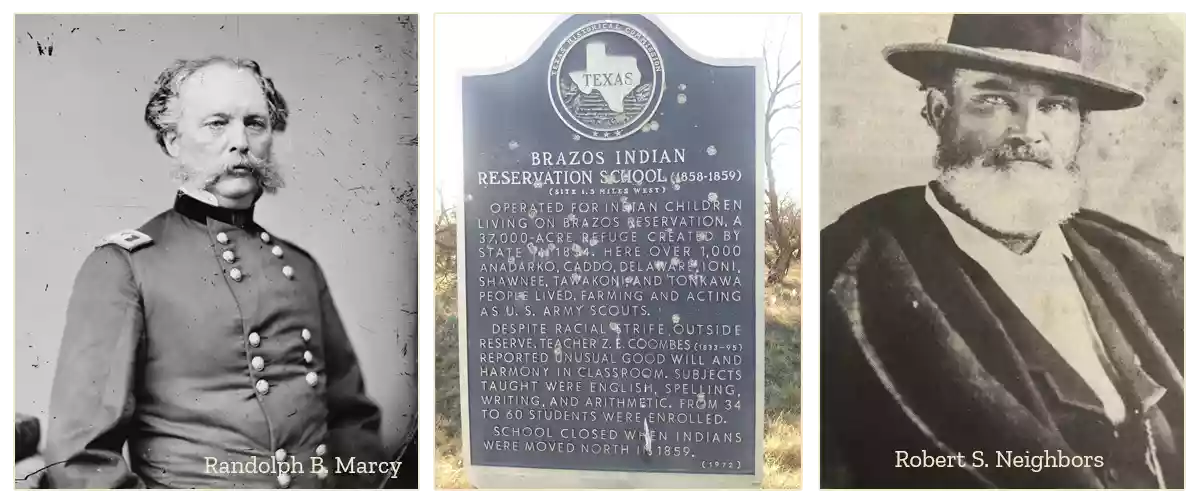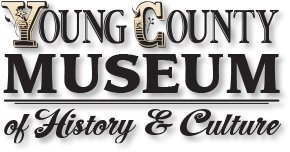
Brazos River Indian Reservations
As reported by the Texas Historical Commission, on this the 26th day of April in 1854, the U.S. War Department ordered Randolph B. Marcy, in conjunction with Indian agent Robert S. Neighbors, to locate and survey land for Indian reservations in unsettled territory, preferably on timbered land of good soil adjacent to navigable water. Marcy was familiar with Texas, and this would be his fourth expedition on behalf of the government.
On the surveying trips General Marcy told the Indian chiefs that the government was going to supply them with land so that they might raise crops and live peacefully like the white man. This was a hard task to orient the Indians to, as most of the tribes were warrior cultures where hunting and war with other tribes established a man’s place within the tribe.
Eventually the diminishing tribes of the Anadarkoes, Caddoes, Wacoes, and Tonkawas agreed to the reservation plan, mainly as a refuge from the Comanches. The sites selected after consultation with the various Indian groups concerned were four leagues of land 17,712 on the Brazos River below Fort Belknap for the Anadarkoes, Caddoes, Wacoes, Indians, and another tract of the same size forty miles away on the Clear Fork of the Brazos for the use of the Comanches. A third tract of four leagues adjoined the one on the Brazos and was intended for the use of the Indians living west of the Pecos River, chiefly the Mescalero and Lipan Apaches. These western Indians, however, failed to come into the reservation, and this tract was added to the Brazos agency, making that reservation total eight leagues.
The reservation land was part of the vacant domain of Texas, which was given to the Federal Government, but Texas retained the right of jurisdiction over persons other than Indians for any offense committed by such person or property of anyone within the limit of the state. The federal government had jurisdiction over the Indians within the reservation and a further ten-mile boundary around the reservation to prevent the sale of alcohol to the tribes.
The Brazos River Indian Reservation Agency Building was located near Dry Creek, three miles west of the present sight of Graham. Two agents were appointed for the reservations, under the supervision of Major Robert Neighbors; Captains Shapley Ross and J.R. Baylor. After a year and a half, Baylor was replaced by Matthew Leeper. Baylor was indignant at being released and became a serious point of contention, stirring up racial trouble between the Indians and the settlers.
Almost all of the ranchers who settled into the area were familiar with the reservation Indians, who had proved to be successful farmers, raising cops to rival any farmers in the area. Between fifty and one hundred Indians were even listed in the Rangers service at that time, and though they were used for frontier protection, it raised the animosity of certain white settlers. The rancher’s cattle grazed all over the unfenced and unlimited country. The Indians and Agents made no protest, for grass was free and plentiful. To be fair, certain Indians also exploited their new neighbors, appearing at the door of a ranch stating “Me friend,– me no kill, –give me cow–. (From the book “A history of Young County Texas”, by Carrie Crouch).
But there was a class of white men, known as filibusters, who opposed any Indian presence in the area, and did not hesitate to kill an Indian off the reservation. One incident which caused the federal government to send more troops to Fort Belknap, and eventually led to the Indians being moved to Oklahoma was the murder of Choctaw om’s party in Palo Pinto County. Old Choctaw Tom was known to settlers in the area, even before the reservations. Choctaw Tom made friends with new people arriving to the area and often assisted them as nurses and servants.
In December 1858 Choctaw Tom, having received a permit from the Agent, took seventeen people into Palo Pinto County on a hunt. On the night of December 26, 1858 Tom’s party was attacked while asleep and eight were killed, found the next morning still under their blankets. Toms’ wife had been killed, his daughter shot in the hand, Tom was wounded.
This act put the Indians on the reservation in an uproar, and it took a great deal of diplomacy on the part of Colonel Ross to curb an Indian uprising. The government promised swift justice, but not one indictment was served, fueling tension even more.
On May 23, 1859, a large group of armed men were reported to be on the reservation and Captain Plummer of Fort Belknap was dispatched to ascertain their intentions. Upon locating the group, Plummer learned it was led by Captain Baylor, the ex-agent who stated that they were looking for certain Indians and that should US Troops interfere they would be fired on. Plummer returned to the Fort for reinforcements. During the interim, they discovered an elderly Indian that they promptly scalped, and learned that an elderly Indian Women was standing there when the evil deed occurred and they promptly killed her as well.
The outlaws under Baylor retreated to the Marlin Ranch and were still there when fifty braves from the reservation arrived bent on revenge. US Troops arrived on the scene soon after, but having no jurisdiction off the reservation, they sat and waited on the outcome. Chief John Polock Mark and Chief John Hatterbox, both elderly, challenged Baylor to single combat, but Baylor refused. A gun battle ensued, and Chief Hatterbox was killed almost immediately and two of Baylor’s party were killed before the Indians withdrew at sundown.
With the tension in the area set to explode, Major Neighbors put in for and executed an order for the removal of the Indians from the Brazos River Reservation. Both reservations reverted to the state when the Indians were removed to the Indian Territory in 1859.

